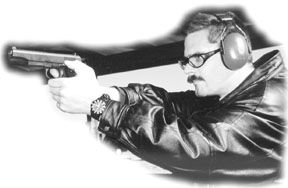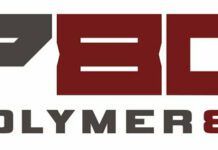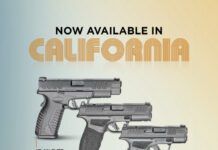
The Browning 1911 single-action pistol and big 0.450- to 0.452-inch bullets are synonymous. So is a level of power that demands respect, not to mention the recoil that goes with it. But it doesn’t have to be that way. You can enjoy the benefits of the 1911 design with what we found to be a pleasing flash and satisfying jolt simply by rolling back the clock almost a hundred years ago.
The original chambering for the Browning semiauto design was in .38 ACP, but in 1907 the gun was rechambered for the .45 ACP round, and it was that variant that won the United States military contract and eventually became the model designation 1911.
Meanwhile, the original .38 ACP languished, but in 1929 this cartridge had been upgraded to handle more pressure. It was renamed the .38 Super Auto +P. The Super operates at about the same pressure as 9mm Luger, 33,000 c.u.p., but the Super case is longer than the Luger (0.900 inch versus 0.754 inch) and can hold more powder. In fact, the Super case has been handloaded successfully for years with slower burning powders that are compressible to produce even higher velocities than originally expected.
So what would happen when we took a gun built to handle the .45 ACP and stuffed today’s hottest factory .38 Supers into it? The happy result: A tame 1911 with friendly recoil, single-handed operation and the natural pointing ability of a single-stack frame with greater capacity than when similar guns are loaded with .45s. Our test guns were the $682 Springfield Armory’s Mil Spec, which in some ways commemorates the original model, as we’ll discuss. Next up was a much less expensive pistol by Armscor of the Philippines, the $425 38P FS, followed by a High Standard Crusader, $679, which included an SFS system that makes possible chamber-loaded carry with the hammer down without introducing an extra step when it comes time to fire.
Range Session
We had planned to fire our full-sized Government models outdoors with targets placed 25 yards downrange. In fact we had even completed our tests of the Springfield when sudden high winds forced us to seek the friendlier confines of an indoor range. Thus, we retested the Springfield Mil Spec again indoors for the sake of continuity.
We retreated to the 50-foot lanes of Top Gun in Houston, (713) 779-4867, to fire five-shot groups seated from a sandbag rest at three-inch bulls. Prior to our accuracy tests, each gun was treated to a break-in session of 50 to 100 rounds, but lubrication was our first step.
[PDFCAP(1)]We took the top ends off and lubed the frame and slide rails, the lug cuts in the slide, the link and barrel feet, lower barrel area, barrel interior, disconnecting plunger and each side of the hammer. Last, we treated the outer diameter of the barrel with BreakFree with the slide locked back to lubricate the inner diameter of the barrel bushing.
We shot two 130-grain roundnosed full metal jacket cartridges from Federal and Winchester, along with a defense round from Cor-Bon, the 125-grain JHP cartridge that boasts a velocity of 1350 fps on the box. Here’s what we found.
Armscor 38P FS, $425
The 38P FS manufactured by the Arms Corporation of the Philippines and imported by API in Las Vegas is the least expensive pistol in this test. This is a clean, sleek pistol with several upgrades from a base 1911 configuration, including cocking serrations on the front and rear of the slide, a skeletonized hammer, skeletonized trigger, ambidextrous thumb safeties, serrated magazine release, raised and extended beavertail grip safety, and Novak sights.
[PDFCAP(2)]The front blade is tall and distinctive and the rear unit is drift adjustable for windage only, fixed by a setscrew. As with all three of our test pistols, recoil travels over a short guide rod with lockup via a standard barrel bushing. None of our pistols proved stubborn to break down, and we were able to forego the use of a bushing wrench.
The bluing of this pistol is even and rich. The grips are plastic, but checkered. While the backstrap is lined, the front strap is smooth and would benefit from checkering or grip tape, in our view. Still, we recognize that holding on to these pistols is not a big issue.
Despite high velocities the low mass of the .38 Super slugs combined with the all-steel construction of these pistols adds up to lighter than expected recoil.
But just in case, we brought along a pair of “Burner” Grip Panels from Barnhart International. Designed by champion Practical Shooter and trainer Jerry Barnhart, these grips were intended for use by SEAL Team units that often face wet conditions.
Consisting of a fine sandpaper-like finish over cocobolo wood, they should be enough to solve anyone’s grip problems no matter how sweaty one’s hands become. When we put them on the gun, we felt really locked in, and there was never a need to re-grip the pistol between shots.
In terms of performance our Armscor pistol displayed both strengths and weaknesses. Accuracy proved to be this pistol’s strength. While its performance with the Federal ammunition was similar to that of the Springfield Mil Spec, it was the clear winner firing both the Winchester and Cor-Bon ammunition. While we feel that 15 yards should not be a challenge to full-sized pistols it is nonetheless a realistic test-distance for combat firearms. The Armscor pistols averaged just over 2.2 inches per five shot groups with all ammunition. But there must be some qualification here.
Each of our pistols showed characteristics that are not necessarily deal breakers, but still require more refinement to overcome. Each of the pistols preferred to be charged by first locking back the slide and releasing it with the mechanical lever rather than pulling the slide back as in the “slingshot” method. This was most noticeable when loading hollow point ammunition. Rounds would typically nose-dive inside the magazine. We also noticed a preponderance of first shot flyers. The semi-automatic pistol is meant to index the slide consistently to the same point each time. This not only aligns the sights but also locks up the barrel. Lockup is best achieved when the slide is moved rapidly by the force of a fired round. Releasing the slide by hand in any manner will likely not apply the type of force necessary to lock up the pistol as was intended. Some of our best groups were actually attained on shots two through six after a settling shot was released into the berm.
A problem we encountered with the Armscor pistol was a deal breaker. We suffered several failures to ignite when loading the Winchester and Cor-Bon rounds. This was confusing because the indentation on the primers seemed sufficiently deep for ignition. However, we noticed the hits on the primer were off center. This alone could stifle ignition because the interior construction of centerfire primer is designed to respond to concussion from the center outward. We think the problem was an oversized firing pin hole. Instead of the firing pin moving straight to the primer, the oversized hole was allowing the firing pin to glance off to the side. This hole was simply poorly placed and out of round, in our view. We reason that the Federal ammunition did not fail because Federal is known to use a softer cap on the primer.
High Standard Crusader, $685
The list of identical measurements and features shared by each of our .38 Supers is long. But the High Standard Crusader from Firearms International of Houston brings with it the option of the “Safety-Fast” SFS system.
[PDFCAP(3)]This system adds a hammer block and allows for safe, hammer-down carry. After chambering a round, the hammer typically stays back but with the SFS system installed it can then be lowered manually, preferably with the weak hand thumb. Actually the hammer assumes a position that leaves about one-sixteenth inch of space between the firing pin and hammer face. When the safety lever is depressed from either side, the hammer jumps back and, with the grip safety depressed, will now fall when the trigger is activated.
It could be argued that this is merely an image-related gadget because even with the hammer down, disengaging the safety brings about the same condition as cocked and locked. Be that as it may, we found the SFS system greatly increased our comfort level with the 1911 especially during common administrative handling. We reviewed the SFS system in the March 2001 issue (Cylinder and Slide, [800] 448-1713). The Crusader is available with or without the SFS, and the company will install the SFS on compatible guns for $125 parts and labor.
In testing the Crusader, our only problems were encountered when we experienced failures to eject on our first two rounds of Winchester “round ball” jacketed ammunition. The empty case went straight upward and lodged itself directly above the breechface. We also noticed that it would not chamber the hollowpoint Cor-Bon ammunition.
Taking a look inside the Crusader, we noticed the barrel was not ramped in the same fashion as the Sprinfield. In our view, this created a need for consistent alignment between the mouth of the chamber, the feed ramp set in the frame, and the magazine fit. The Crusader comes with a MetalForm magazine , a reputable brand. But as an experiment we tried the magazine from the Springfield Armory pistol. This mag features an entirely different follower more typical of the Chip McCormick design. Our hunch paid off and the Crusader ran trouble free from then on.
In our view, this pistol would benefit from a raised-profile grip safety such as the one on the Armscor pistol. Those shooters without a meaty palm hesitated because they could not be sure that the Crusader’s grip safety was being adequately depressed. A raised-profile grip safety is available for $25 installed. Another point on which the Crusader seemed to differ from its competitors was in what we believed were cast parts. We thought the barrel seemed to be solid steel pressed into a cast shroud. The frame also appears to be cast, as does the link pin and slide release. Cast parts are generally considered to be less durable than parts made from solid bar stock and are more difficult to machine to edges of fine tolerance. With the top end removed for example, we noticed a burr atop the frame on the forward portion of the barrel support and even a little bit of premature wear.
However, gunsmith John Ford, who assembles the Firearms International .45s, said none of the parts, but particularly the barrel shroud, were cast.
Also, in our opinion the High Standard Crusader was hampered by a too-brief front blade, and the rear sight is right off the Spanish 1911s complete with centering notch atop the slide. This part was dovetailed in but not properly fixed. Ours was found to be loose after the tests were completed. During the tests we complained that the face of the rear sight was delivering a horizontal line of glare that was so bold it appeared to be painted on. We liked the Novaks on the Armscor pistol because they added almost a half-inch of sight radius over a standard rear notch. The Springfield sights were likewise tall and bold.
The Crusader has wood grips, a pleasant and predictable trigger and the SFS system. Regarding the aforementioned first shot flyers, we thought the Crusader was much improved in this category using the Springfield/McCormick magazines. With this magazine in place the pistol actually produced a single five-shot group of the Cor-Bon measuring 1.8 inches without having to dump the first shot. (We did not list this group in our official data because it was not achieved using the original High Standard part.)
Springfield Mil Spec 1911A1, $682
As previously stated, we found shooting the 1911 design with .38 Supers to be very comfortable, and among our three test samples the Springfield Mil Spec was the most desirable of all.
[PDFCAP(4)]The Mil Spec model is in some ways a commemorative pistol without getting gaudy or expensive. It has classic styling including a basic military style grip safety and solid hammer tang. Sights are certainly not snag resistant but are tall and clear with a modern upgrade to a three-dot system. The mainspring housing is arched, something we don’t see much of anymore and the hard plastic, fully checkered grip panels are held in place by standard slotted screws. The trigger is solid metal, but the ejection port is flared and the entire package comes in a no-glare Parkerized finish. This gun also includes Springfield’s safety system that key locks the mainspring.
Fit and finish is first rate. There are no cast parts on this pistol, but it sells for the same amount as the High Standard Crusader. Before high winds and cold temperatures forced us to take our tests indoors, we had already completed field tests with this pistol firing at 25 yards. We found that the traditional 130-grain ball ammo was nowhere near as accurate as the hollowpoints. Including the aforementioned first round flyers (which were less prevalent with this pistol), five-shot groups were in the 4-inch range. While ball ammo runs and shoots very well in the .45 ACP 1911s, the venerable 130-grain round nose leaves much to be desired in the Super. The Cor-Bon rounds (even when producing more than 500 foot-pounds of energy) did not seem to kick very hard and delivered the best accuracy. At twenty-five yards from a seated rest, groups of less than 2.5 inches were common. This showed us the gun had consistent lockup, quality magazines, satisfactory slide to frame fit, and suitable sights.
Gun Tests Recommends
High Standard Crusader, $679. Conditional Buy. For $679 we feel this pistol should have more modern features and offer a solid steel platform that would be worth adding to. With better sights and a lower price, we’d think about buying the Crusader.
Armscor 38P FS, $499. Don’t Buy (as tested). On the sample we tested, we’d have to have the breechface and/or slide replaced to ensure reliable ignition. How the company responds to such a request would determine if we would consider it.
Springfield Armory Mil Spec 1911A1, $682. Buy It. Frankly, this pistol felt entirely different in the hand than its two competitors. It had a solid feeling that lends confidence. There is room for improvement, in our view, but for most buyers, just matching it with the right ammo would be enough.




























